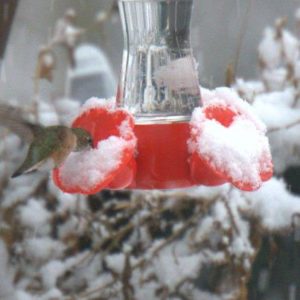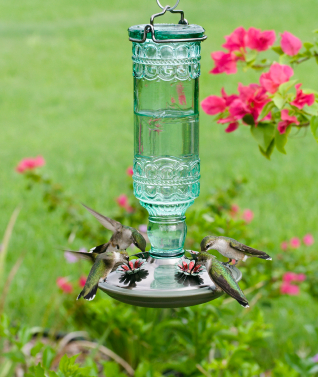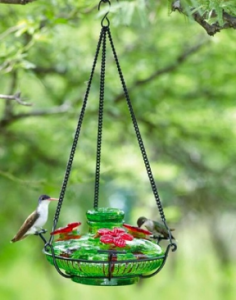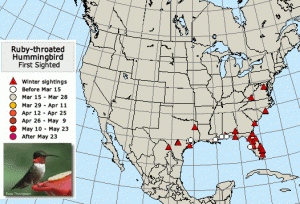-
Regardless of what the groundhog says…hummingbird feeders!
What’s wrong with this picture? It hasn’t been photo-shopped or altered, and it’s certainly a real hummingbird. Oddly enough, these tropical migratory birds have been known to overwinter on several occasions. Nobody really knows why they would even want to stay and brave such harsh weather, especially when all their buddies head south… a mere 3 to 5 thousand miles! This nectar can’t be all that special?
On Cape Cod, there was even a big news story last year, where one lonely Ruby Throated was made famous! A few residents were hanging heat lights over their hummingbird feeders to keep nectar from freezing! Another reported bird made headlines in North Carolina too.
Regardless of what Punxsutawney Phil decides, hummingbird feeders should be out, filled and ready before the birds actually make their way to your neck of the woods. Project Ruby Throat and some other sites even track the great migration, with reports of the first birds arriving from the south and their directional sprawl north, east and west.
Since hummingbirds are so darn territorial, it might be a good idea to start thinking about adding an additional feeder this year, especially if you’d like to see more of the buzzing antics in your yard. If you hosted them last year… the same ones will likely return! And if you’ve never made your own nectar… this is definitely the season to start! We think the birds prefer the home made solution over commercial mixes any day. NO red dye needed. The recipe is so simple, it’s table sugar (cane sugar only) and water… that’s it! Check out some suggested plantings (along with the recipe) that will help lure the birds as well.
And make a vow to keep feeders fresh this year, hummingbirds may not return to a feeder that has spoiled nectar. Every two to three days nectar should be changed in the height of summer and extreme temps. You may not want to fill the feeder all the way unless most of the nectar is being used in between cleaning and filling.
Here’s hoping for an early spring!
-
Extra Hummingbird Feeders…please?
It’s that time of year again, when the daylight hours start to dwindle, and the southern migrations begin. Most notably, the hummingbird migration, because if you’ve been feeding the little sprites through summer… there’s no way you can miss the frenzy around feeders!
Activity around hummingbird feeders is just mad! Almost in a frantic, and desperate attempt to guard their spots, hummingbirds are buzzing like crazy, and drinking down nectar from big feeders in a matter of one to two days.
They know it’s critical to fatten up for the long journey back to Central and South America, just imagine how much fuel that takes? And summer weather has not been kind to them…or any other wildlife for that matter 🙁
The brutal temps and severe drought killed off most of the flowers and shrubs that provide nectar. This makes the trip for hummingbirds up North a bit more difficult. They’ll search for activity (other hummingbirds at feeders) as they make their way through the southern states.
Consider adding another feeder, or even two, that will increase the likelihood of more successful flights home. And if you think your hummingbirds are gone, please wait for the slow-pokes and stragglers! Some folks keep feeders out year-round, as strange sitings have revealed the migratory bird in northern states during frigid winter months.
Nectar solutions may also be increased this time of year to benefit hummingbirds. The usual ratio of 4:1 is perfect during lazy summer months, but these guys mean business now! Increase the ratio to a 3:1 solution for added calories. Three cups of water to one cup plain table sugar. If you feed commercial nectar mixes, just use about 25% less water for an added punch.
If hummingbirds graced your yard this year, chances are they’ll be back next year. Practicing “site fidelity” is another really cool thing about these fascinating birds. And hey, even if it’s just one of those little plastic inexpensive hummingbird feeders (that doesn’t much appeal to you) they will absolutely appreciate and love it right now!
-
Boiled Hummingbird Feeders?
In anticipation of the great hummingbird migration, all the hummingbird feeders were pulled from storage last night. With the mild winter season we’ve had in the South, the little sprites may be returning earlier than usual this year. Such an endearing and favorite of all our migratory friends, we roll out the red carpet so to speak!
One of the plastic hummingbird feeders was looking a bit cloudy, although it was cleaned prior to storing last season. While making the first batch of nectar (so simple-recipe below) I had the brilliant idea to pour some of the boiling water in the feeder to “clear it up”. The feeder proceeded to melt in my hand… I couldn’t grasp what was happening at first, until I ended up with a Salvador Dali-looking hummingbird feeder! Really should have taken a picture, but was too disappointed in my better judgement. The feeder’s usable for now, but it sure does look funky.
This is exactly why we prefer blown glass or ceramic hummingbird feeders over plastic ones. The quality just can’t be compared. Instead of buying a new feeder every other season, handcrafted hummingbir
d feeders from artists and companies like Parasol and even BirdBrain will last a lifetime. They can be run through the dishwasher for easy cleaning, and they’ll never turn cloudy or yellow over time. The Dali-looking feeder will now be replaced for the last time with this beauty.
Here’s a map showing the first sightings for Ruby Throats in the South and Southeast, with some who’ve even wintered up North. Brave little guys… it won’t be long now! Find the really easy nectar recipe to fill your hummingbird feeders below, they like it better than commercial mixes too 🙂
Mix 1 cup plain table sugar to 4 cups water. NOTHING ELSE, no substitutes as they may be harmful or even fatal to hummingbirds. Plain, Pure Cane Sugar is the only ingredient to use for nectar. No red dye either, it’s a big myth! There’s no need to boil the water, as any organisms spread are by the hummingbirds’ beaks. We do boil one cup of water, simply to dissolve the sugar more effectively. Let cool, fill feeders, and store unused nectar in the fridge for up to two weeks. That’s it! If you’ve never made your own nectar, we encourage you to try it this season, hummingbirds seem to prefer it, and it will be the least expensive bird food all year!





